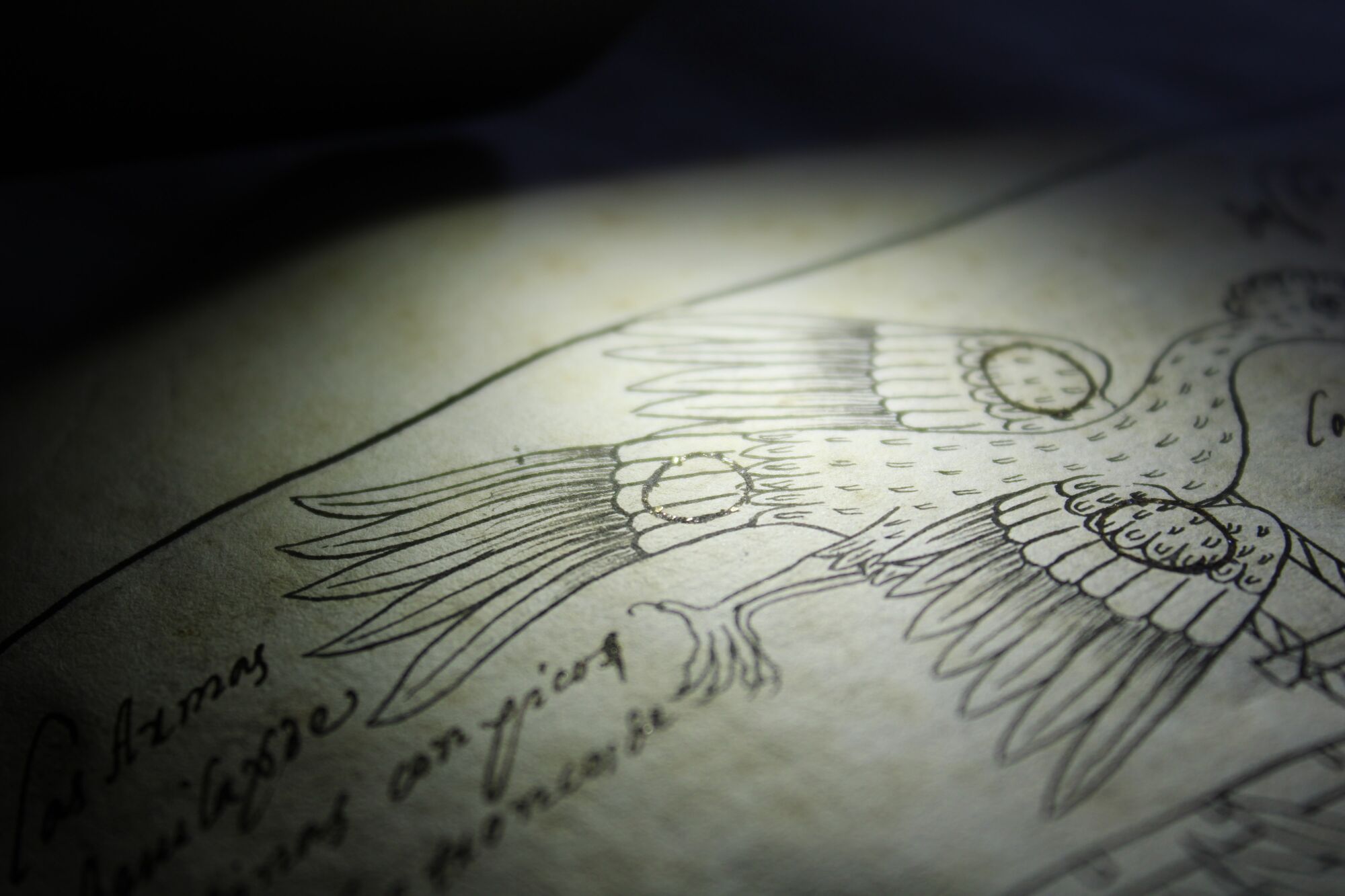
About the exhibition
Re:reading explores libraries and collections as dynamic collaborative spaces, where fresh insights can be uncovered through evolving scholarship, fresh analytical techniques and novel interpretations of collections.
Re:reading is divided into five sections, showcasing exciting collaborative projects the University Library has been involved with in recent years, alongside a range of academic colleagues and creative partners.
Topic of Conservation
The ‘Tlaxcala Codex’ – or manuscript – is key to our understanding of the Spanish conquest of Mexico and is of international, cultural and historical importance.
For many years the manuscript has been in high demand for research, teaching and exhibitions, but until recently access has been limited due to its many conservation issues.
A grant from the National Manuscripts Conservation Trust enabled the University Library to conserve the Codex, digitise it and make it fully accessible to a worldwide research audience. It can be accessed in full on JSTOR.
The manuscript was compiled by Diego Muñoz Camargo, the son of a Spaniard and an indigenous Tlaxcalan woman. The work was presented to King Philip II of Spain as a diplomatic gift in 1584-85.
An ink drawing of a traditional Mesoamerican calendar Library conservation staff analyse a manuscript under magnification. Ref: MS Hunter 242, inserted between folio 177 and 178

Ink drawing of Spanish and Tlaxcalans fighting together to defeat their common enemy, the Aztecs (or Mexicas). Ref: MS Hunter 242, folio 267r
Creative Collaborations
Untitled Projects theatre company aims to make adventurous theatre on a large scale. The company’s work contemplates the future, collaborating with academics, scientists and now archivists.
The Untitled Projects Collection is part of the Scottish Theatre Archive and is at the heart of an ongoing collaboration between the theatre company, the University Library and academics in Theatre Studies.
The collection includes a rich variety of materials, from scripts and sketches to photographs, videos, marketing materials, costumes, and design models.
By unpicking the record-keeping activity concerned with design, production and staging of Untitled Projects’ work, archivists are reflecting carefully on the question ‘What is an archive?’ and theatre practitioners are reflecting on how archives and archivists are perceived by broader society.
Untitled Projects Exhibition Videos

Production shots, Drowned Giant (2000)

Video still, Paul Bright’s Confessions of a Justified Sinner (2013-2015)
The Work of Art
In 2020, Turner Prize-winning artist Elizabeth Price was awarded a Library Research Fellowship to explore the Stoddard-Templeton Archive, as inspiration for a new artwork.
Featuring unique material from two of Scotland’s most important carpet designers and manufacturers, the collection was acquired by the University in 2008, in partnership with Glasgow School of Art and Glasgow Life.
After participating in the Fellowship programme, Price staged her first solo exhibition in Scotland, UNDERFOOT, at The Hunterian in 2022-23.
UNDERFOOT drew on the archives to create an ambitious moving image work and bespoke textile piece focused on Glasgow’s rich textile heritage. The exhibition explored power dynamics in the industrial process, politics of gender and class, and the development of data storage and technology.
Price’s work also provoked a deeper reflection on the very concept of a library as a space - not only for knowledge but also for memory, power, and access. Who and what are libraries for?
The Work of Art Exhibition Videos

Finishing room, James Templeton & Co Ltd

Floral carpet design ‘Tigris’, c1960s. Ref: STOD/DES/93/12
Machine Learning
Following the 1833 Abolition of Slavery Act, more than 800,000 enslaved Africans were freed from working on plantations in the British Empire. Around this time plantation owners sought innovative ways to maintain their profits, turning to new engineering technologies.
Glasgow companies like Mirrlees, Watson & Co Ltd specialised in the design and manufacture of equipment for processing sugar, and thousands of machine tools were shipped from Glasgow to ports in the Caribbean.
Within the Scottish Business Archive, financial ledgers and order books contain data showing where new industrial technologies were being deployed throughout the British Empire.
Today, the archives of sugar machinery manufacturers are being reinterpreted using 21st-century methods, offering new insights to the post-abolition era.
Machine Learning Exhibition Video

Index page for machinery order book, Demerara, 1851-1911. Ref: UGD118/4/5/2

Technical data for clients in Guyana and Puerto Rico, Mirrlees & Tait, 1864. Ref: UGD202/2217-2219, 2226/p277
Reading Data
Who was the most popular author of the Scottish Enlightenment?
We often think of figures like Adam Smith or Robert Burns as central to the period, but how can we be sure that Scots actually read their works?
The innovative Books and Borrowing research project goes some way to answering these questions and shed new light on the history of reading in Scotland.
It began at the University with Eighteenth Century Borrowing from the University of Glasgow. Funded by the Chancellor’s Fund and the Carnegie Trust, the team digitised, transcribed and analysed three 18th-century borrowing registers from the University Library, creating a wealth of data about which books were most borrowed and by whom.
The project expanded to include borrowing records from seventeen other historic Scottish libraries, creating a database that reveals the reading habits of everyone from poachers to gamekeepers, vagabonds to members of the professional and leisured classes. This collection of data opens the door to a new, evidence-based reappraisal of the books that shaped Scotland’s intellectual and cultural history.
Top 10 titles borrowed at University of Glasgow, 1751-1823
- Universal History, from the Earliest Account of Time to the Present
- Charles Rollin: Ancient History of the Egyptians, Carthaginians, Assyrians, Babylonians, Medes and Persians, Macedonians, and Grecians
- Paul Rapin de Thoyras: History of England
- David Hume: History of England
- Samuel Clarke: Sermons
- Homer: The Illiad
- Frances Hutcheson: System of Moral Philosophy
- Livy: History of Rome
- Xenophon: Works
- The Monthly Review

The Lending Library (c 1800-1811). A hand-coloured drawing by Isaac Cruikshank. Yale Center for British Art, Paul Mellon Collection



